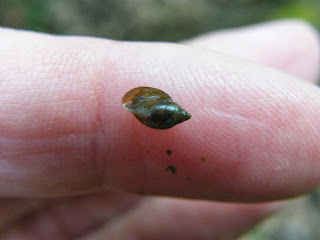28 September
9AM
Ashland Nature Center
Hockessin, DE
On September 28th, the Naturalist Certification Class, led by Kristin Travers, did a survey of the Red Clay Creek to determine its health and learn some things about aquatic ecosystems.
Just looking at Red Clay Creek, one can see that it's a likely place to find macroinvetebrates. The movement and clarity of the water shows that there is oxygen in the stream. In addition, the stream is healthy enough to support vegetation on either side.
For comparison, here is a creek at Lums Pond that does not have as much oxygen, but does have healthy vegetation. The low oxygen in the stream makes it an unfavorable habitat for fish, but, like Delaware's inland ponds, a good place for reptiles and amphibians.
| Still stream |
When I dug up some of the sediment from the bottom of the creek, I didn't find any living organisms.
Riffles are the best place to find macroinvertebrates--they are places where the current is interrupted by rocks or logs, creating a safe habitat for the small organisms to hide and cling. In fact, the macroinveterbates we found tried to cling to anything they could find in the trays, including each other.
At Red Clay Creek, we used simple tools to survey the living organisms in the water: nets, small plastic containers, buckets, and out feet to stir up the sediment.
 |
| Using the net |
 |
| Sorting through to see what we found Kristin also had a scope we could look through:  |
When we had gotten some organisms in the bucket, we left the creek and deposited them in ice cube trays to sort them.
 | ||
| Leaving the creek Here are the organisms we found: Damselfly larva (Damselflies, like dragonflies, are in the order Odononata)
|
 |
| Water penny (larvae from the family Psephenidae) |
 |
| Planaria (non-parasitic flatworm) |
 |
| Another damselfly larva |
The Big Three of stream health are the larva of the cranefly, stonefly (order Plecoptera), and mayfly (order Ephemeroptera, literally "wings that last a day"). These are indicator species because they can only live in very healthy water. Although we found only one or two of each of these, Kristin told us that ten years ago, there would have been none. Red Clay Creek has been undergoing rehabilitation since its time as a dump stream for industrial chemicals in Wilmington. There should be more mayflies, stoneflies, and craneflies, but it's a start.
 |
| Cranefly larva (members of a family in the order Diptera) |
 |
| Another view of the cranefly larva |
 |
| Crayfish |
Scuds
Stonefly larva
 |
| Orange caddisfly larva |
 |
| Underside of dragonfly larva, showing powerful jaw |

 |
| Diana's waders did not pass the test |





No comments:
Post a Comment